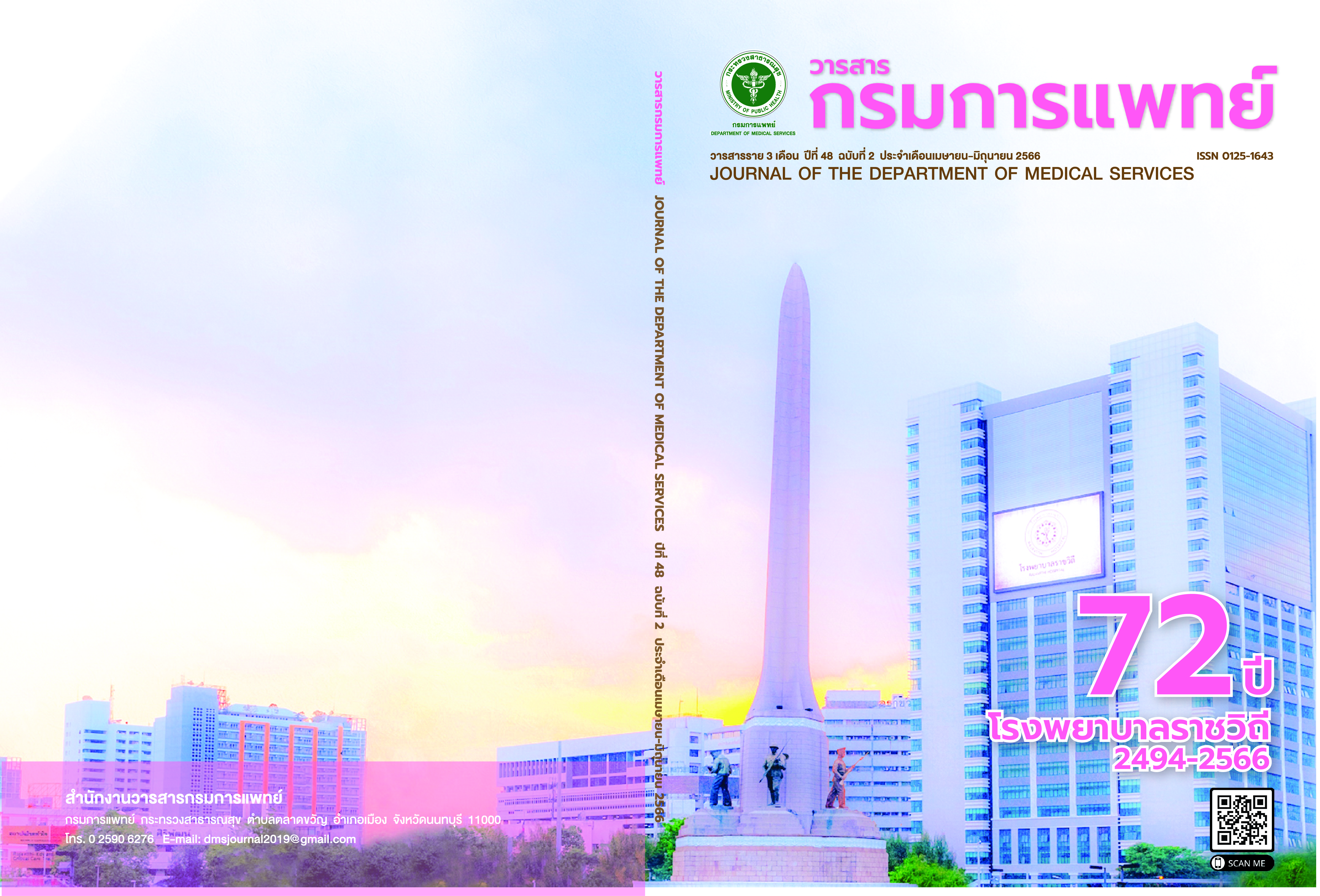Development of A Care Model for Patients with Parkinson’s Disease at Chiang Mai Neurological Hospital
DOI:
https://doi.org/10.14456/jdms.2023.25Keywords:
Patients with Parkinson’s disease, Care model for patients with Parkinson’s disease, Research and developmentAbstract
Background: Parkinson’s disease (PD) is a chronic neurodegenerative disease, that poses incurable threat to thepublic health and to the quality of life of people living with PD . In this regard, having an appropriate caring processfor patients with PD could be helpful to reduce the complications and improve their quality of life. Objective: Themain objective was to develop a care model for patients with PD. The specific objectives consisted of exploring 1) the situation of nursing care for patients with PD, 2) the components and model of nursing care for patients with PD, and 3) the feasibility of model implementation. Method: There were 4 phases of Research and Development Method of this research, namely 1) situational analysis, 2) model development, 3) model implementation, and 4) evaluation and conclusion of the feasibility of the model implemented from November 2021 to July 2022. Results: 1) the challenges of nursing care provision to patients with PD included patients’ limited knowledge of PD and self-care, low quality of life among patients with PD, caregivers’ inadequate knowledge of PD and caregiving skills, healthcareproviders’ insufficient caregiving skills, and lack of a multidisciplinary care system; 2) the components of care and caremodel for patients with PD comprised promoting patients’ health literacy encouraging family members’ participationin providing care for the patient with PD, and increasing healthcare providers’ competencies in patient care; and 3) the feasibility study of model implementation revealed that the scores on knowledge of PD, medication adherence,and quality of lifeof patients with PD; and the scores on knowledge of PD and readiness of being caregiver of familymembers; as well as the scores on knowledge of PD of nurses significantly increased. Conclusion: The applicationof this nursing care model helped increase the efficiency of care for patients with PD. It enabled the patients withPD to gain more knowledge and understanding on the disease and self-care procedure. It also enhanced familymembers’ as well as healthcare providers’ abilities to provide proper care to the patients with PD
References
Lee TK, Yankee EL. A review on Parkinson’s disease treatment.Neuroimmunology and Neuroinflammation 2021; 8:222–44.
Pirtoˇsek Z, Bajenaru O, Kovacs N, Milanov I, Relja M, Skorvanek M.Update on the management of Parkinson’s disease for generalneurologists. Parkinson’s Disease 2020; 2020: 1-13.
Tipsiri R. A Guide to the Rational Use of Parkinson’s Medicineaccording to the National List of Essential Medicines. National DrugList Subcommittee and Special Force 2019.
Ferrazzoli D, Ortelli P, Zivi I, Cian V, Urso E, Ghilardi MF, et al. Efficacyof intensive multidisciplinary rehabilitation in Parkinson’s disease: arandomised controlled study. J Neurol Neurosurg Psychiatry 2018;89(9):828-35.
Rudzinska M, Bukowczan S, Stożek J, Zajdel K, Mirek E, Chwała W,et al. The incidence and risk factors of falls in Parkinson disease:prospective study. Neurol Neurochir Pol 2013; 47(5):431-7.
Fereshtehnejad SM, Ghazi L, Shafieesabet M, Shahidi GA, Delbari A,Lökk J. Motor, psychiatric and fatigue features associated withnutritional status and its effects on quality of life in Parkinson’sdisease patients. PLoS One 2014; 9(3):e91153.
Nazem S, Siderowf AD, Duda JE, Brown GK, Ten Have T, Stern MB,et al. Suicidal and death ideation in Parkinson’s disease. Mov Disord2008;23(11):1573-9.
Simpson J, Lekwuwa G, Crawford T. Illness beliefs and psychologicaloutcome in people with Parkinson’s disease. Chronic Illn 2013;9(2):165-76.
Ditratchakit C. Experiences of Lining with Parkinson disease ofThai elderly. Police Lieutenant Colonel Chollada Ditruchgij 2011;3(1):74-88.
Boland DF, Stacy M. The economic and quality of life burdenassociated with Parkinson’s disease: a focus on symptoms. Am JManag Care 2012; 18(7Sappl):S168-75.
Peachpunpisa C. Caregiver in Parkinson’s Disease Patient. Journalof Phrapokklao Nursing College 2015; 26(Sappl):111-6.
Peters M. Quality of Life and Burden in Caregivers for Patients withPD. Focus on Parkinson’s Disease 2014; 24:201-13.
Padovani C, Lopes MC, Higahashi IH, Pelloso SM, Paiano M,Christophoro R. Being caregiver of people with Parkinson’s Disease:experienced situations. Revista brasileira de enfermagem. 2018;71(Sappl6): 2628-34.
Aphisitphinyo S, Arunpongpaisal S, Tiamkoa S, Paholpak P.Prevalence of Major Depressive Disorder in Parkinson’s Disease atSrinagarind Hospital. J Psychiatr Assoc Thailand 2017; 62(27):167-76.
Del-Pino-Casado R, Espinosa-Medina A, López-Martínez C,Orgeta V. Sense of coherence, burden and mental health incaregiving: A systematic review and meta-analysis. J Affect Disord2019; 242:14-21.
Perez E, Perrin PB, Lageman SK, Villaseñor T, Dzierzewski JM.Sleep, caregiver burden, and life satisfaction in Parkinson’s diseasecaregivers: a multinational investigation. Disabil Rehabil. 2022;44(10):1939-45.
Techagahakit W. Kanyanee P. Direct Costs of Parkinson’s Diseaseat Suratthani Central Hospital: a Retrospective Study. Journal ofHealth Science 2016; 25(1):69-75.
Burn N, Grove SK. Nursing research. 5th ed. U.S.A.: W.B. SaundersCompany; 2005.
Paynter C, Mathers S, Gregory H, Vogel AP, Cruice M. Using theConcept of Health Literacy to Understand How People Livingwith Motor Neurone Disease and Carers Engage in Healthcare: ALongitudinal Qualitative Study. Healthcare (Basel) 2022; 10(8):1371.
Salinas MR, Chambers EJ, Ho T, Khemani P, Olson DM, Stutzman S,et al. Patient perceptions and knowledge of Parkinson’s disease andtreatment (KnowPD). Clin Park Relat Disord. 2020 Jan 16; 3(3):100038.
Fleisher JE, Shah K, Fitts W, Dahodwala NA. Associations andimplications of low health literacy in Parkinson’s Disease. MovDisord Clin Pract. 2016; 3(3):250-6.
White DR, Palmieri PA. Women Caring for Husbands Living withParkinson’s Disease: A Phenomenological Study Protocol. J PersMed. 2022; 12(5):659.
Villaseñor T, Perrin PB, Donovan EK, McKee GB, Henry RS,Dzierzewski JM, et al. Parkinson’s family dynamics and caregiversense of coherence: A family-systems approach to coping in Mexicoand the United States. Aging Med (Milton) 2020; 3(4):252-9.
Padovani C, Lopes MCL, Higahashi IH, Pelloso SM, Paiano M,Christophoro R. Being caregiver of people with Parkinson’s Disease:experienced situations. Rev Bras Enferm. 2018; 71(Sappl6):2628-34.
Prachuablarp C. Nurse Competencies in Caring Patients withParkinson’s Disease. Journal of The Royal Thai Army Nurses 2015;16(1):1-7.
Downloads
Published
How to Cite
Issue
Section
License
Copyright (c) 2023 Department of Medical Services, Ministry of Public Health

This work is licensed under a Creative Commons Attribution-NonCommercial-NoDerivatives 4.0 International License.
บทความที่ได้รับการตีพิมพ์เป็นลิขสิทธิ์ของกรมการแพทย์ กระทรวงสาธารณสุข
ข้อความและข้อคิดเห็นต่างๆ เป็นของผู้เขียนบทความ ไม่ใช่ความเห็นของกองบรรณาธิการหรือของวารสารกรมการแพทย์



